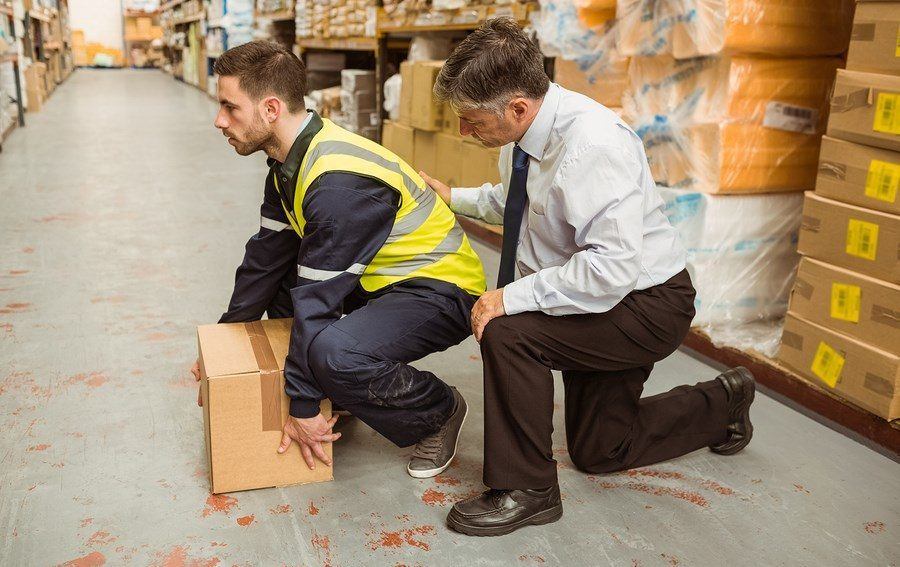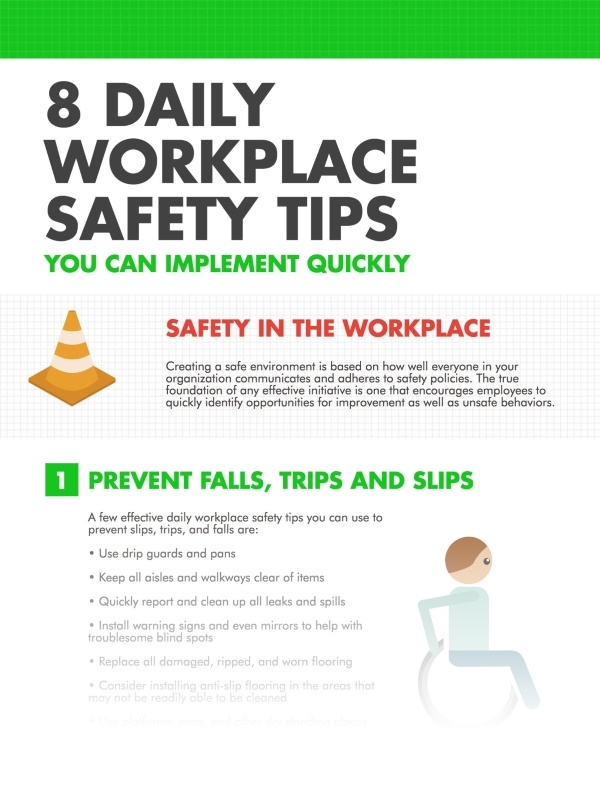
Safety in the workplace cannot exist on best practice policies and guidelines alone. Creating a safe environment is based on how well everyone in your organization communicates and adheres to safety policies. The true foundation of any effective initiative is one that encourages employees to quickly identify opportunities for improvement as well as unsafe behaviors.
Instead of thinking of safety as a passive measure, you can break organizational it down into daily steps. These are actionable things everyone in the organization can do each day to ensure a higher level of assurance as well as productivity. The following information explains eight daily workplace safety tips you can quickly implement for shared responsibility throughout the organization.
See the 8 Safety Tips in Our Infographic
Click to view full infographic »
1. Prevent Falls, Trips, and Slips
According to data from the Bureau of Labor Statistics, slips, trips, and falls were one of the leading causes of illnesses and nonfatal occupational injuries in 2013. Regardless of your industry or sector, you should always make sure floors are clean and dry in storerooms, passageways, and service rooms. A few effective daily workplace safety tips you can use to prevent slips, trips, and falls are:
- Use drip guards and pans.
- Keep all aisles and walkways clear of items.
- Quickly report and clean up all leaks and spills.
- Install warning signs and even mirrors to help with troublesome blind spots.
- Replace all damaged, ripped, and worn flooring.
- Consider installing anti-slip flooring in the areas that may not be readily able to be cleaned.
- Use platforms, mats, and other dry standing places where useful.
2. Always Stay Aware of Your Surroundings
It's imperative your staff remains mindful of their surroundings. Most importantly, they should be cognizant of all of the known hazards in the workplace. After you have named these risks, you should post signs as a part of your safety management system to keep workforce alert and conscious any potential hazardous situations and areas. You should also ensure the employees are keen of the hazards associated with all machinery and equipment on the worksite.
3. Ensure Everyone Takes Regular Breaks
A large number of work-related illnesses and injuries happen because a worker is burned out, tired, or unconscious of their surroundings. The best way to avoid this inherent hazard is to ensure everyone takes their regular breaks, especially with labor intensive work, such as construction and manufacturing. While management may be inclined to promote skipping breaks with intentions of increased productivity, breaks ensure everyone stays fresh and observant. Another tip is to schedule the more difficult tasks when employee's concentration is the best, such as right after a break in the morning.
4. Always Use Machines and Tools Properly
Anytime staff members are working with tools and equipment, it's vital they use them properly and never take shortcuts. Shortcuts are one of the primary causes of injuries on the jobsite. For instance, employees shouldn't use a scaffold as a ladder or one tool instead of another for a job. Using the right tools every time will reduce the overall likelihood of injuries. You can also host continuing education courses as reminders about the importance of safety.
5. Protect Your Back By Using the Correct Posture
Whether the work environment is an office or at an energy production plant, it's important employees protect their back and use correct posture. Using correct posture means picking things up with the correct form and avoiding twisting and stooping. If at all possible, the work area should be furnished with safety equipment and ergonomically designed furniture.
6. Report Dangerous Conditions to Management
Anytime hazards exist or there are unsafe working conditions, management should be alerted immediately. Although management is responsible for maintaining a safe work environment, it becomes infinitely more difficult to achieve this goal if they are unaware of the danger. Safety is everyone's responsibility, and non-management staff must report unsafe conditions to management for a solution.
7. Ensure All Workers Wear the Proper Safety Equipment
Failing to wear the right personal protective equipment (PPE) equipment for the job is one of the most common culprits for serious injuries and fatalities. The type of PPE should change based on the task and industry. For instance, someone working in the space and defense industry would require different PPE than someone in field services. Some of the most common personal protective equipment includes:
- Hard hats
- Earmuffs
- Earplugs
- Gloves
- Goggles
- Respirators
- And more
It's imperative your employees always wear the right equipment to reduce the likelihood and severity of injuries on the jobsite.
8. Contact Premier Safety Partners for More Daily Workplace Safety Tips
In the end, it's up to business owners and facility managers to ensure everyone adheres to protocol to reduce vulnerability. Management should encourage the workforce to get active in the process by implementing effective checklists and other valuable tools. You can also reward workers for their ability to exemplify excellent safety behavior.
Contact Premier Safety Partners today for more helpful tips to increase workplace safety.






